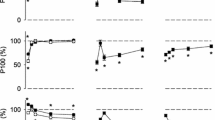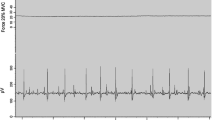Summary
Fatiguing contractions of the adductor pollicis muscle were produced by intermittent supramaximal stimulation of the ulnar nerve in a set frequency pattern, in six normal subjects. At the end of an initial fatiguing contraction series, low frequency fatigue (LFF) had been induced and persisted at 15 min of recovery. Stimulated fatiguing activity was then repeated in an identical fashion to the initial series. At high frequencies, declines in force were similar for both series. At low frequencies, declines in force were greater during the second series despite similar changes in compound muscle action potential amplitude. This confirmation that LFF persists during subsequent stimulated activity, and reduces low but not high frequency fatigue resistance, suggests that the impaired endurance of fatigued muscle during voluntary activity primarily results from peripheral changes at low frequency. These findings also have implications for therapeutic electrical stimulation of muscle.
Similar content being viewed by others
References
Belanger AY, McComas AJ (1983) Contractile properties of muscles in myotonic dystrophy. J Neurol Neurosurg Psychiatry 46:625–631
Cooper RG, Edwards RHT, Gibson H, Stokes MJ (1988) Frequency dependence of excitation and force generation in human adductor pollicis. J Physiol 397:585–599
Davies CTM, White MJ (1981) Muscle weakness following eccentric work in man. Pflugers Arch 392:168–171
Edwards RHT (1983) Biochemical basis of fatigue in exercise performance: catastrophe theory of muscular fatigue. In: Knuttgen HG, Vogel JA, Poortmans J (eds) Biochemistry of exercise. Human Kinetics, Champaign, pp 3–28
Edwards RG, Lippold OCJ (1956) The relation between force and integrated electrical activity in fatigued muscle after exercise. J Physiol 132:677–681
Edwards RHT, Hill DK, Jones DA, Merton PA (1977) Fatigue of long duration in human skeletal muscle after exercise. J Physiol 272:769–778
Edwards RHT, Griffifths, RD, Cady EB (1985) Topical magnetic resonance for the study of muscle metabolism in human myopathy. Clin Physiol 5:93–109
Efthimou J, Belman MJ, Holman RA, Edwards RHT, Spiro SG (1986) The effect of low frequency fatigue on endurance exercise in the sternomastoid muscle of normal man. Am Rev Respir Dis 133:667–671
Efthimou J, Fleming J, Spiro S (1987) Sternomastoid muscle function and fatigue in breathless patients with severe respiratory disease. Am Rev Respir Dis 136:1099–1105
Gandevia SC, McCloskey DI (1978) Interpretation of perceived motor commands by reference to afferent signals. J Physiol 283:493–499
Gibson H, Cooper RG, Stokes MJ, Edwards RHT (1988) Mechanisms resisting fatigue in isometrically contracting human skeletal muscle. Q J Exp Physiol 73:903–914
Jones DA (1981) Muscle fatigue due to changes beyond the neuromuscular junction. In: Porter R, Whelan J (eds) Ciba Foundation Symposium. Human muscle fatigue: physiological mechanisms. Pitman Medical, London, pp 178–196
Komi PV, Viitalaso JT (1977) Changes in motor unit activity and metabolism in human skeletal muscle during and after repeated eccentric and concentric contractions. Acta Physiol Scand 100:246–254
Krarup C (1981) Enhancement and dimunition of mechanical tension evoked by staircase and by tetanus in rat muscle. J Physiol 311:355–372
Lewis T (1918) The “effort syndrome”, its symptoms and signs, contrasted with those of heart disease. In: Soldier's heart and the effort syndrome. Shaw, London, pp 10–26
Merton PA (1954) Voluntary strength and fatigue. J Physiol 123:553–564
Miller RG, Giannini D, Milner-Brown HS, Layzer RB, Koretsky AP, Hooper D, Weiner MW (1987) Effects of fatiguing exercise on high-energy phosphates, force, and EMG: evidence for three phases of recovery. Muscle Nerve 10:810–821
Moxham J, Morris AJR, Spiro SG, Edwards RHT, Green M (1981) Contractile properties and fatigue of the diaphragm in man. Thorax 36:164–168
Ranatunga KW (1979) Potentiation of the isometric twitch and mechanism of tension recruitment in mammalian skeletal muscle. Exp Neurol 63:266–276
Sargeant AJ, Dolan P (1987) Human muscle function following prolonged eccentric exercise. Eur J Appl Physiol 56:704–711
Stokes MJ, Cooper RG, Edwards RHT (1988) Normal muscle strength and fatiguability in patients with ‘effort syndromes’. Br Med J 297:1041–1047
Vandervoort AA, Quinlan T, McComas AJ (1983) Twitch potentiation after voluntary contraction. Exp Neurol 81:141–152
Wiles CM, Young A, Jones DA, Edwards RHT (1979) Relaxation rate of constituent muscle fibre types in human quadriceps. Clin Sci 56:47–52
Author information
Authors and Affiliations
Rights and permissions
About this article
Cite this article
Stokes, M.J., Edwards, R.H.T. & Cooper, R.G. Effect of low frequency fatigue on human muscle strength and fatigability during subsequent stimulated activity. Europ. J. Appl. Physiol. 59, 278–283 (1989). https://doi.org/10.1007/BF02388329
Accepted:
Issue Date:
DOI: https://doi.org/10.1007/BF02388329




